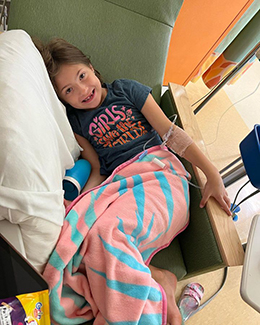Children with Fabry today can have different lives than I had
Taking ERT infusions earlier can make a difference in the disease's symptoms

This month, my niece Katrina posted a happy birthday message on Facebook to her daughter, Isabella, my grandniece who turned 8 years old this month. Katrina describes her as sweet, spunky, and stubborn. I’m not surprised to hear she’s stubborn, as the trait seems to be in our family genes. Like the Fabry disease gene, stubbornness comes out in me and several other family members.
Stubbornness isn’t always a bad thing. I give it credit for helping me overcome many obstacles I’ve faced on what I call “a road less traveled,” my column’s theme. Many times, I refused to give up against great adversity. I’ve been near death a few times. I’ve gratefully lived much longer than I expected with Fabry.
Isabella — like me, one of her brothers, her mother, her first uncle, and her grandmother (my sister) — has Fabry. Many more extended family members have it, too, but because our family tree continues to grow and branch out, it’s hard to keep track of everyone.
The road people with Fabry travel can be extremely difficult, frightening, and painful. The disease is a multisystem disorder, with many common effects that adversely affect quality of life — and it can be life-threatening over time.
Isabella is experiencing a couple of firsts this month. She went to her first concert with one of her brothers, Landon, to see Kidz Bop. I can’t tell you anything about that group, but for many of us, our first concert is memorable. In fact, I still remember mine from about 50 years ago: Alice Cooper in Detroit. If you know about Alice Cooper, you probably see a side of me that you didn’t expect. It makes me laugh, too!
Isabella’s other first this month is a major event: She started biweekly intravenous (IV) infusions of enzyme replacement therapy (ERT) to treat Fabry. Starting ERT is a big deal for children and parents alike. When parents think about their children and the pain of the IV needle sticks, the hours lost to lengthy infusions, the days of missed school, and the ongoing symptoms of Fabry, it can be very daunting.

Isabella gets her first ERT infusion. (Courtesy of Katrina Whitaker)
Starting ERT reminds me of the saying, “It’s going to get worse before it gets better.” Fabry symptoms don’t usually subside immediately. In particular, many people report that Fabry’s neuropathic pain gets worse before it gets better. ERT seems to awaken nerves and cause more pain initially and for a while. At least, that was true for me when I started ERT.
But because Isabella is young, she may not experience this phenomenon.
In contrast to Isabella, I started ERT at 48 years old. Since then, I’ve had more than 500 infusions over 20 years, which means I’ve been stuck with an IV needle about 1,000 times. On average, I get two sticks a visit. It’s not the most fun thing I do in my life, but I’m grateful to still be upright and doing well.
I have had a few bumps on my road, however, culminating in a heart transplant about three years ago. I’d like to get ERT for another 10 or 20 years; it’d give me something amazing to talk about.
ERT is now the only Fabry-specific therapy available for children, so Isabella and others around her age are stuck with it (pun intended) for now. The oral chaperone therapy, approved for adults, is not approved for children.
By starting ERT at an early age, perhaps Isabella can live a much better and longer life than she might otherwise. Treatment can slow or even halt the disease progression in various organs and tissues, so she may not experience significant dysfunction or damage in her brain, kidneys, and heart. It may also improve other symptoms to give her a better life.
We hope children like Isabella won’t need ERT for 20 years; we hope improved treatments with easier delivery methods won’t require infusions. Meanwhile, along with being brave, as she was for her first infusion, I trust that she’ll also find her stubbornness useful as she builds resilience to meet the challenges of traveling her own road less traveled.
I’ve had a glimpse at Isabella’s and her brother Ryan’s potential futures. (Landon, it turns out, does not have Fabry.) I have several friends with children who started ERT at early ages and are now at the age of most college students. They excel in sports like baseball, track and field, and martial arts. Ryan, 16, plays on a baseball team, and Isabella is learning gymnastics.

Isabella, 8, trains in gymnastics. (Courtesy of Katrina Whitaker)
I hope the neuropathic pain, chronic gastrointestinal problems, reduced ability to perspire, frequent overheating from physical activity, extensive missed school, and low self-esteem I and many others experienced in childhood won’t be part of the journey for Isabella, Ryan, or any other child, since available treatment can slow the course of Fabry. And a new world awaits!
Note: Fabry Disease News is strictly a news and information website about the disease. It does not provide medical advice, diagnosis, or treatment. This content is not intended to be a substitute for professional medical advice, diagnosis, or treatment. Always seek the advice of your physician or other qualified health provider with any questions you may have regarding a medical condition. Never disregard professional medical advice or delay in seeking it because of something you have read on this website. The opinions expressed in this column are not those of Fabry Disease News or its parent company, Bionews, and are intended to spark discussion about issues pertaining to Fabry disease.








Susanna VanVickle
Jerry,
thanks for this beautiful column. I am so glad Isabella is doing well.
The decision whether or not to do ERT for my daughter has been very difficult... so I especially appreciate this positive story.
Elizabeth Hunt (Fabry New Zealand)
Hi Jerry
Thankyou for sharing your grandniece's story. I too have grand daughters 12 and !5 years old who will have Fabry through their Dad, my middle son. Fortunatey as far as I know they are not exhibiting symptoms yet. At this stage ERT is not available in our country which highlights the contrast between my two sons who live in Australia on the oral trreatment Migalastat-- but were on ERT - and and my son here to whom this is still unavailable
Diane Rothman
Jerry, you and your family are inspiring!
Kristi Winchester
This is amazing, and I'm so thankful for your leadership in this community. Thank you for this article! Very inspiring for our family and young daughter with Fabry.